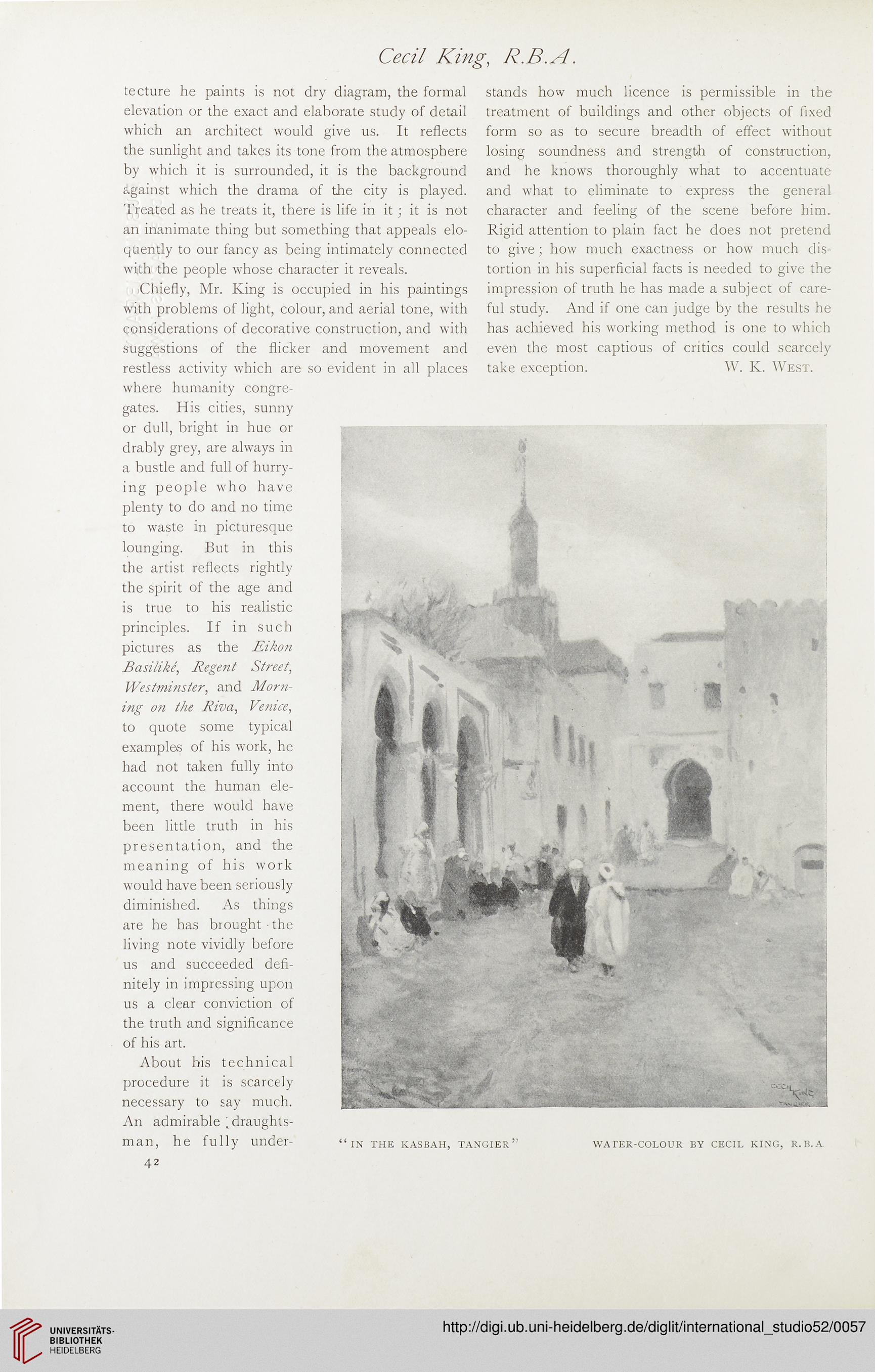Cecil King, R.B.A.
tecture he paints is not dry diagram, the formal
elevation or the exact and elaborate study of detail
which an architect would give us. It reflects
the sunlight and takes its tone from the atmosphere
by which it is surrounded, it is the background
against which the drama of the city is played.
Treated as he treats it, there is life in it; it is not
an inanimate thing but something that appeals elo-
quently to our fancy as being intimately connected
with the people whose character it reveals.
Chiefly, Mr. King is occupied in his paintings
with problems of light, colour, and aerial tone, with
considerations of decorative construction, and with
suggestions of the flicker and movement and
restless activity which are so evident in all places
where humanity congre¬
gates. His cities, sunny
or dull, bright in hue or
drably grey, are always in
a bustle and full of hurry¬
ing people who have
plenty to do and no time
to waste in picturesque
lounging. But in this
the artist reflects rightly
the spirit of the age and
is true to his realistic
principles. If in such
pictures as the Eikon
Basilike, Regent Street,
Westminster, and Morn¬
ing on the Riva, Venice,
to quote some typical
examples of his work, he
had not taken fully into
account the human ele¬
ment, there would have
been little truth in his
presentation, and the
meaning of his work
would have been seriously
diminished. As things
are he has biought the
living note vividly before
us and succeeded defi¬
nitely in impressing upon
us a clear conviction of
the truth and significance
of his art.
About bis technical
procedure it is scarcely
necessary to say much.
An admirable draughts¬
man, he fully under-
42
stands how much licence is permissible in the
treatment of buildings and other objects of fixed
form so as to secure breadth of effect without
losing soundness and strength of construction,
and he knows thoroughly what to accentuate
and what to eliminate to express the general
character and feeling of the scene before him.
Rigid attention to plain fact he does not pretend
to give; how much exactness or how much dis-
tortion in his superficial facts is needed to give the
impression of truth he has made a subject of care-
ful study. And if one can judge by the results he
has achieved his working method is one to which
even the most captious of critics could scarcely
take exception. W. K. West.
“in the kasbah, tangier”
WATER-COLOUR BY CECIL KING, R.B.A.
tecture he paints is not dry diagram, the formal
elevation or the exact and elaborate study of detail
which an architect would give us. It reflects
the sunlight and takes its tone from the atmosphere
by which it is surrounded, it is the background
against which the drama of the city is played.
Treated as he treats it, there is life in it; it is not
an inanimate thing but something that appeals elo-
quently to our fancy as being intimately connected
with the people whose character it reveals.
Chiefly, Mr. King is occupied in his paintings
with problems of light, colour, and aerial tone, with
considerations of decorative construction, and with
suggestions of the flicker and movement and
restless activity which are so evident in all places
where humanity congre¬
gates. His cities, sunny
or dull, bright in hue or
drably grey, are always in
a bustle and full of hurry¬
ing people who have
plenty to do and no time
to waste in picturesque
lounging. But in this
the artist reflects rightly
the spirit of the age and
is true to his realistic
principles. If in such
pictures as the Eikon
Basilike, Regent Street,
Westminster, and Morn¬
ing on the Riva, Venice,
to quote some typical
examples of his work, he
had not taken fully into
account the human ele¬
ment, there would have
been little truth in his
presentation, and the
meaning of his work
would have been seriously
diminished. As things
are he has biought the
living note vividly before
us and succeeded defi¬
nitely in impressing upon
us a clear conviction of
the truth and significance
of his art.
About bis technical
procedure it is scarcely
necessary to say much.
An admirable draughts¬
man, he fully under-
42
stands how much licence is permissible in the
treatment of buildings and other objects of fixed
form so as to secure breadth of effect without
losing soundness and strength of construction,
and he knows thoroughly what to accentuate
and what to eliminate to express the general
character and feeling of the scene before him.
Rigid attention to plain fact he does not pretend
to give; how much exactness or how much dis-
tortion in his superficial facts is needed to give the
impression of truth he has made a subject of care-
ful study. And if one can judge by the results he
has achieved his working method is one to which
even the most captious of critics could scarcely
take exception. W. K. West.
“in the kasbah, tangier”
WATER-COLOUR BY CECIL KING, R.B.A.




